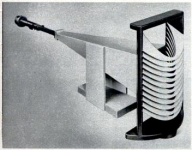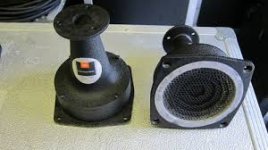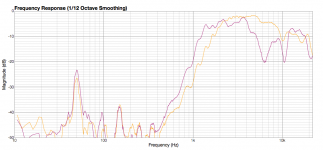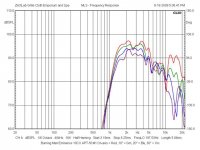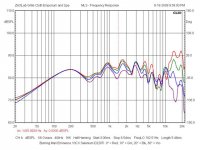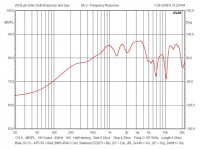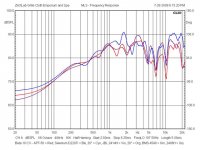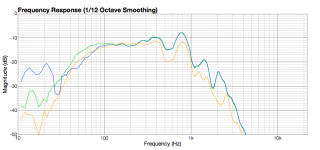I should point out I do not work for Eminence and will not be selling anything that comes out of this experiment. My contact at Eminence just want to hear the end product. 🙂
Attachments
Last edited:
If you don't mind would you translate a small part of the article linked above?
Vaan onko näillä asioilla oleellista vaikutusta? Ei, ei ole. Pölykupin poiston tuoma diskanttitason desibelin-parin nousu tarkoittaa, että sitä ylädiskanttia pitää sitten vaimentaa jakosuotimessa enemmän. Tarkoittaa pykälää tai paria suurempaa vastusta. En näe pointtia. Mutta se pölykuppihan oli vain ovi, jonka kautta päästään leikkelemään basson puhekelan runko kartion tasolle? Josta ei seuraa mittauksissa minkäänlaista hyötyä verrattuna vakioelementtiin. Beta-10CX:n diskanttitoisto oli aivan yhtä rosoinen suoraan edestä mitattuna vakioelementillä, ilman pölykuppia olevalla muuten vakioelementillä ja puhekelan rungoltaan lyhennetyllä elementillä.
Vain jos leikkausjätettä sattuu saamaan sinne ilmarakoon, se sekä näkyy mittalaitteistolla että kuuluu äänen lopullisena vaimentumisena.
- See more at: Kaiutinrakennusohje Yksisilmäiset veljekset - hifi-PA-kaiuttimet Eminence Beta-8CX, Beta-10CX ja Beta-12CX -koaksiaalielementeistä | AudioVideo.fi
This was about modifying the coaxial. This is not a direct translation but same things in english.
People use a lot of time removing the dustcap and shortening voicecoil's former that protrudes a bit. We made measurements with standard CX10, one without dustcap and one with the former also shortened. The ragged area in measurements look like Himalayas in all three. From a bit different angles in each, but Himalayas anyway.
This is when you measure (or listen) on axis. Moving just 15-20 degrees off, the difraction problem goes away. And since we usually get only 10-20% sound straight from loudspeakers and the rest from room reflections, the diffraction problem is far from as big problem as you could thing just watching the on axis measurement.
So if you want coaxial that has a very good response (i.e. very smooth transition from compression driver to woofer's cone), buy BMS or PHL (and a BMS compression driver for it). They just are not very suitable for passive loudspeaker with very simple crossover.
Some people claim that just removing the dustcap improves high frequencies. Yes, you do get 1-2dB more in the highest octave. But if you need to attenuate them anyway much more, it's just the resistor in crossover, take one or two steps smaller and it's the same. And if you get something in the airgap, you definetly get difference in sound - maybe a total silence 🙂 .
Putting these behing acoustically transparent screen is an excellent idea (I did, 50 litre sealed enclosures filled with wool). Probably you need to adjust the crossover a bit to compensate the screen - tweeters resistor one or two steps smaller and the cap parallel to it one or two steps bigger. One step is enough with the best screens (I use Screen Excellence 4K), two steps with the thicker ones.
And to emphasize one more time. Do make the 12-incher, 10 and 8 are same price and not quite as good as the Beta-12CX + APT:50. At least my ears get tired after a short period with the smaller ones and if I attennuate the ragged high mids and top more, they sound just dull.
Yes, and it's not only the diffraction but also that there is no control from horn below 8kHz. With the 8CX, for my ears, attenuation was not a good enough fix because too much is needed to preserve any normal balance, but it is the only way to prevent harsh sound, at least without drastically modifying the driver. Just as you said here (I did not try the 12, but it would not have been appropriate for my project):The big point was to adjust tweeters balance - a little attennuation in 2-8kHz area and a bit more sparkle to top octave. All the coaxials, CX8, CX10 and CX12 are far from perfect wave guides to the tweeter and with flat balance the top is very unpleasent because of diffractions. However, if you attennuate the problem area just a bit the annoyance disappears.
Do make the 12-incher, 10 and 8 are same price and not quite as good as the Beta-12CX + APT:50. At least my ears get tired after a short period with the smaller ones and if I attennuate the ragged high mids and top more, they sound just dull.
Yes, and it's not only the diffraction but also that there is no control from horn below 8kHz. With the 8CX, for my ears, attenuation was not a good enough fix because too much is needed to preserve any normal balance, but it is the only way to prevent harsh sound, at least without drastically modifying the driver. Just as you said here (I did not try the 12, but it would not have been appropriate for my project):
The woofer's cone is part of the waveguide, not just the short horn inside woofers pole piece. The biggest problem is the transition from small horn inside the pole piece to the woofers cone. If that transition is smooth, the overall balance can also be smooth. It is like any round horn with mouth as big as woofer's cone but with the sharp angle in the middle.
I attached a pic of APT:50-driver in Beta-CX10 (purple) and excatly same driver in Eminence's own plastic horn i.e. APT:150 (yellow). Because CX10 is bigger, it boosts the drivers response to about octave lower than small APT:150-horn. But because the horn-profile of CX10 is worse, we can see the Himalayas in tweeter response.
This is why at least I see no point in using better and more expensive drivers with Eminence coaxials. The cheap APT:50 is not the problem, the coaxial's construction is. You can put any driver and still get the horrible looking (and less horrible sounding) tweeter response - the horn profile of CX-series is not getting any better with changing compression driver.
Attachments
The woofer's cone is part of the waveguide, not just the short horn inside woofers pole piece. The biggest problem is the transition from small horn inside the pole piece to the woofers cone. If that transition is smooth, the overall balance can also be smooth. It is like any round horn with mouth as big as woofer's cone but with the sharp angle in the middle.
I attached a pic of APT:50-driver in Beta-CX10 (purple) and excatly same driver in Eminence's own plastic horn i.e. APT:150 (yellow). Because CX10 is bigger, it boosts the drivers response to about octave lower than small APT:150-horn. But because the horn-profile of CX10 is worse, we can see the Himalayas in tweeter response.
This is why at least I see no point in using better and more expensive drivers with Eminence coaxials. The cheap APT:50 is not the problem, the coaxial's construction is. You can put any driver and still get the horrible looking (and less horrible sounding) tweeter response - the horn profile of CX-series is not getting any better with changing compression driver.
Thank you for translating that section.
What crossover points and slope did you use for the 10cx and the 12cx?
The dips at 5.2 and 10.4kHz look like they may be caused by destructive interference from 2.6khz. I have seen people getting better results with XO in the 1.5-1.75kHz range 18db/octave acoustic. Did you observe this?
Yes, and it's not only the diffraction but also that there is no control from horn below 8kHz.
I am curious how you got that number. My calculations would give the centre horn alone control to ~2150Hz
Circumfrence x π =lowhornwavelength
13524in/s / 6.28 wavelength = 2153.5Hz
I could be completely wrong I will double check this.
An exact equation for this with all the variables including woofer induced turbulance would be impossible within reasion so I choose to estimate some factors.
If I calculate using the 10cx cone it is down near 400Hz so with a two octave margin 1750Hz seems optimal as an XO as long as the CD can do it.
Last edited:
Attachments
I am curious how you got that number.
From measurement. I should have worded it differently maybe. There is some frequency where it would lose directivity, but the woofer cone also controls directivity, and then there's a ton of diffraction/reflection/resonance/whatever.
Whatever exactly is going on, the result is that the woofer cone keeps things pretty orderly up to some frequency (~2.8k in my measurement of the 8CX <post #6>) and then over some range in the upper mids / lower treble (differs between the three sizes), things get messy and wide dispersion, leaving you with a juggling act to try to get something balanced-sounding. Pretty normal problem for coax drivers.
In Zilch's measurements of the 10CX you posted, I'm not sure what's happening - very strange how different the two CDs are at 4k. edit: nevermind, the different frequency lines between the two graphs tricked me.
Last edited:
From measurement. I should have worded it differently maybe. There is some frequency where it would lose directivity, but the woofer cone also controls directivity, and then there's a ton of diffraction/reflection/resonance/whatever.
Lots of issues no doubt.
Whatever exactly is going on, the result is that the woofer cone keeps things pretty orderly up to some frequency (~2.8k in my measurement of the 8CX <post #6>) and then over some range in the upper mids / lower treble (differs between the three sizes), things get messy and wide dispersion, leaving you with a juggling act to try to get something balanced-sounding. Pretty normal problem for coax drivers.
That is why I want to experiment with a acoustic lens. BTW I have no idea how this will work out. My hunch is that by using a small diffusion lens in front of the dust cap I can spread the on axis energy out a bit more evenly. Or I could end up with mayhem. 😛
Thank you for translating that section.
What crossover points and slope did you use for the 10cx and the 12cx?
The dips at 5.2 and 10.4kHz look like they may be caused by destructive interference from 2.6khz. I have seen people getting better results with XO in the 1.5-1.75kHz range 18db/octave acoustic. Did you observe this?
The crossover is around 1,5kHz, a bit lower with 12CX than 10CX of course - bigger cone/waveguide boosts tweeters performance to lower frequencies. Electrical slopes are first order for tweeter and second for woofer. Tweeter's horn loading and first order electrical xover is third(ish) octave acoustical.
Practically the first cap in tweeters xover is a hi-pass with very high elecrical xover frequency. It is close match to the tweeter in waveguide's rising response and result is flattish. Then the parallel cap+resistor are used for adjusting the tweeters balance.
There are no upper mid resonances in APT:150 (the plastic horn + APT:50) and there are no upper mid resonances when measuring 20 degrees off axis. So it must be the diffractions from round and far from perfect waveguide - the CX-woofer.
The crossover is around 1,5kHz, a bit lower with 12CX than 10CX of course - bigger cone/waveguide boosts tweeters performance to lower frequencies. Electrical slopes are first order for tweeter and second for woofer. Tweeter's horn loading and first order electrical xover is third(ish) octave acoustical.
Practically the first cap in tweeters xover is a hi-pass with very high elecrical xover frequency. It is close match to the tweeter in waveguide's rising response and result is flattish. Then the parallel cap+resistor are used for adjusting the tweeters balance.
There are no upper mid resonances in APT:150 (the plastic horn + APT:50) and there are no upper mid resonances when measuring 20 degrees off axis. So it must be the diffractions from round and far from perfect waveguide - the CX-woofer.
Good to know, Thank you 🙂
I may end up going with an actual horn versus using the 10cx as the horn.
Last edited:
reference post: Patent US2684724 - Sound wave refractor - Google Patents
plano-concave lens
http://www.google.com/patents/US3735336
plano-concave lens
http://www.google.com/patents/US3735336
Last edited:
Good to know, Thank you 🙂
I may end up going with an actual horn versus using the 10cx as the horn.
Beta-10A and Beta-10CX both have uneven mid frequency response. If you dump the whole coaxial idea, better use some other woofer. And if you keep the coaxial idea, better dump the 10CX anyway and use 12CX 🙂
Beta-10A and Beta-10CX both have uneven mid frequency response. If you dump the whole coaxial idea, better use some other woofer. And if you keep the coaxial idea, better dump the 10CX anyway and use 12CX 🙂
Interesting comment, I am curious as to what you think my application for these drivers is? 😉
I'm just playing with you. This design will not be used for hi-fi playback. I chose these particular drivers specifically for their mid frequency response characteristics.
That was badly worded. "specifically for their mid frequency response characteristics" I should have added "and dynamic capability"
Another consideration is that the 12cx would need a ported box that is too large for my application for it to be tuned to 47hz with the required roll-off. 57l is as large as I can go.
Another consideration is that the 12cx would need a ported box that is too large for my application for it to be tuned to 47hz with the required roll-off. 57l is as large as I can go.
Yes, you need almost 100 litres for ported box with 12CX. But! It works nicely in 50-60ltr sealed... I have three such versions (45 litres actually, very full of wool) behind my acoustically transparent screen at the moment. No, they don't go extremely low but neither does 10CX in same size ported either.
An outdoor ground plane measurement attached (the variation in lowest octave are because of the wind). Green curve is 12CX in 100ltr reflex tuned to about 40Hz, Blue 12CX in same box and reflex ports plugged (so not really closed but close...) and ugly yellow 10CX in 50ltr reflex tuned to 50Hz.
If you pack the 12CX to sealed 50-60ltr you get quite same bass as the 10CX in reflex but with 12CX's better midrange, directivity to lower frequency and sealed enclosures better impulse response.
Attachments
- Status
- Not open for further replies.
- Home
- Loudspeakers
- Multi-Way
- The Eminence Beta CX-10 . What have you done with it lately ?
